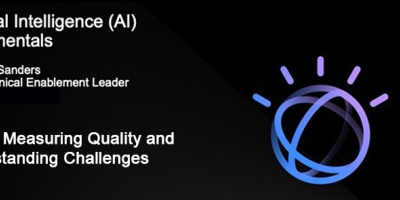Enterprises have used data analytics for decades to seek a better understanding of their business environments. AI is extending the search for such answers into improved predictive analytics, but there are pitfalls to avoid.
Data analytics have long been a keystone to getting a better grasp on existing internal and external business conditions. We're all familiar with descriptive analytics, which deals with, for example, demographic information about current customers, market shares for products and services on offer, and the like. Predictive analytics (PA), in contrast, attempts to answer questions about the future state of a business environment, such as forecasting future sales and inventory needs, predicting production equipment failures, and identifying the impact of potential new products.
PA so far has largely been the domain of human analysts, because humans can assimilate data and then use their imaginations to make informed best guesses about future needs and directions. The handicap humans have lately is that there is far more data to examine than ever before, more than one person—or even a team of people—can take in. While no AI yet has a true imagination, AI PA apps are growing in sophistication and can examine an exponentially greater amount of data than any person.
Using AI, PA blends machine learning (ML), data mining, and statistical modeling to see patterns in larger data sets than before, which can help enterprises better foresee ways in which they can fulfill their missions. Enterprises interested in this growing new dimension of PA can take advantage of this new technology, as long as they keep their eyes open to the organizational challenges of successfully using it.
Taking Stock of the Market
One of the best uses of PA in AI is in marketing. Once trained, AI apps can autonomously use statistical methods to extract trends from large amounts of data rather than rely on traditional methods of using human reactions to data to create forecasting models. Letting a computer do the bulk of the work creates economies of scale because using people for this purpose usually generates higher costs in addition to being able to incorporate only smaller data sets for analysis. Also, there may be a pattern in the data that a human team might miss but an AI app could more easily spot.
Another advantage of using AI for PA is that it's easier to incorporate new methods of data analysis over time via variable algorithms. Human forecasters, in contrast, often rely on habits of thinking that may change only when faced with a significant failure of "tried and true" methods, such as applying historical patterns to current data.
Another advantage is that traditional forecasting is often mostly about using statistics from the past to predict the future, whereas AI PA can review larger amounts of unstructured data, such as social media feeds, to investigate changes in consumer demand and behavior with potentially greater accuracy. Specifically, this might include identifying demographic groups that might be more likely to buy a product or service on offer based on discussion topics of social media users, identifying digital channels that might enhance outreach to potential customers with certain metrics, or targeting content that might match well with something an enterprise offers or may be considering offering.
It's important, though, to pay attention to information obtained by any kind of analytics. A commonly quoted metric is that it costs seven times as much to gain a new customer as it does to retain an existing one. Both descriptive and predictive analytics can be critical tools in helping any enterprise retain customers, but AI PA can provide an important competitive edge.
Predictive Analytics Data Models
PA uses models, which are templates used to analyze and categorize historical data and to differentiate output types. There are five general categories.
Classification models are the simplest. They essentially sort incoming data into true and false buckets based on specific criteria, for example, "do 21-year-old male beer buyers in Northeastern states buy lagers more than ales?" This model tends to be used when seeking decisive answers.
Time series models are used when attempting to determine trends based on the passage of time. These models use historical data to predict future demand—for example, forecasting how many people might be expected to purchase siding in the next month based on the number of applicants in earlier months at a similar time of year.
A forecast model, though similar, looks at data to predict a specific activity from a system. This would be used, for example, to predict how many widgets a machine might produce next week based on an average of how many were produced in some number of previous weeks.
The clustering model groups data according to predetermined characteristics and then subdivides these groups into smaller data sets to make predictions. For example, this type of model might take a universe of recreational vehicle buyers in a certain year, divide them demographically or geographically, and then further classify them based on the type or cost of the recreational vehicles those customers purchased.
Finally, there’s the outliers model. Here, the point is to gather data points that are somehow anomalous when compared to the other members of a data set and try to determine what they have in common. A typical use of this model would be looking for suspicious bank transactions that might need to be more closely examined for signs of fraud.
Overcoming PA Project Challenges
Adopting PA using AI is anything but trivial or straightforward. Not only can there be significant changes to enterprise culture required, there are also a number of other recommended steps to take before adopting an AI PA system. (Admittedly, in an article of this length, we can only cover some high points of each.)
The first step is to develop a strategy for PA use. Questions to be answered include what objectives your enterprise hopes to achieve with AI PA, what problems the enterprise faces that can possibly be solved thereby, what AI PA data models might be the most useful, and what kind of information AI PA might provide that can’t be obtained in sufficient volume or reliability by other means. Simply deciding that sufficient data mining of all available information resources also isn't the best strategic goal; more important is usually deciding what questions are most meaningful to organization goals to ask of what information is available.
Another good early question is to ask what other information sources the organization might try to harvest with PA. How will you decide what sources are important enough to train an AI to review? What actions will be associated with the other items on the task list for the whole implementation?
A key concept of which to be aware is that PA is, at root, about managing enterprise risk. It's easy for some people in any organization to assume that risk is already being handled, so a big data project to further answer it isn't needed. PA advocates should be prepared to estimate the ROI benefits of a new system, and it may be necessary to bring in an outside consultant to build a case that shows sufficient ROI for the C-suite to agree to an AI project.
Somewhat obviously, in hand with this first step is a second step of formulating a budget and the closely associated chore of marshalling organization support for an AI PA system adoption. Budgeting must include expenses of other steps, such as developing expertise and buying software, and will have to include the additional data storage required to support a PA app.
Almost by definition this sort of project crosses organizational boundaries and will therefore have a political aspect. Early buy-in from multiple enterprise groups can be critical to building support.
A third step will be to onboard sufficient expertise to support the new system. This will include data scientists needed to supervise the organization, cleansing, and use of the data that will provide the basis for an AI PA app to do its work. The data scientist will also need to be conversant with statistical modeling and possibly computer languages in which a PA system might be written (e.g., R and Python), although this requirement is becoming less important as PA apps become more user-friendly. It’s important to find personnel with skills in machine learning, predictive model-building, model selection and assessment, and understanding how data algorithms work, among other abilities.
A fourth step has to do with collecting the right data. While the details will have to be handled by specialized personnel, there are certain mandates. A PA system needs data that is clean, correct, and precise, so there must be protocols that ensure that. Data sets must be updated constantly. Extraneous data must be excluded because processing data that can’t provide useful insights will be a waste of resources. How will you make sure incoming data is both complete and accurate? Data entry errors are often human-caused, so if there is dependence on this kind of data input, stratagems such as drop-down boxes for entering common data elements (e.g., names of U.S. states, product names) can reduce errors and enforce style rules for storing some data fields.
A fifth step is cleansing the data an enterprise obtains. While this step will also be largely handled by specific data personnel, in the planning stages there are some issues to be considered. These include whether the obtained data is complete enough to build accurate analysis models, whether the data is granular enough to extract as much meaningful information as possible, whether data could be missing for any number of reasons, and whether there might be additional useful information that could be extracted from the data available if the data model used to analyze it was somehow different.
A sixth step is choosing a PA application and testing it. Recommendations on how to select a software package could fill a book. Suffice it to say the new app should pass the vetting process, the requirements of which for any individual enterprise should have shaken out from previous steps. Pilot testing is a recommended method for trying out PA and other app types to build confidence that any new software can meet organizational objectives for it.
The final step is using PA to its best advantage. This includes finding ways of incorporating PA function into the workflows of end users so they will not hesitate to use a new tool they’re unfamiliar with or may have doubts about. PA also requires strong collection and maintenance procedures to ensure data is accurate and up to date. It requires developing good user habits to be sure that such mistakes as using old data sets to test new hypotheses don't occur. It essentially requires a new culture for the organization in which data is king and good information is as important as money.
Human Behavior Isn't Predictable
Famed science-fiction writer Isaac Asimov, in his seminal Foundation series, posited a future time in which human behavior, at least on the grand scale of history, would one day be predictable by equations yet unformulated. PA can seem like it aspires to that goal, even though that’s not possible now and may never be. But what it can do, by being given the right data and the right models, and by asking the right questions of the data and models, is provide insights into marketing and other aspects of future business actions to a degree never before available. Accessing the information PA can provide requires care, planning, and eternal vigilance on the data front, but it can be an invaluable tool for those willing to take the plunge.























 More than ever, there is a demand for IT to deliver innovation. Your IBM i has been an essential part of your business operations for years. However, your organization may struggle to maintain the current system and implement new projects. The thousands of customers we've worked with and surveyed state that expectations regarding the digital footprint and vision of the company are not aligned with the current IT environment.
More than ever, there is a demand for IT to deliver innovation. Your IBM i has been an essential part of your business operations for years. However, your organization may struggle to maintain the current system and implement new projects. The thousands of customers we've worked with and surveyed state that expectations regarding the digital footprint and vision of the company are not aligned with the current IT environment. TRY the one package that solves all your document design and printing challenges on all your platforms. Produce bar code labels, electronic forms, ad hoc reports, and RFID tags – without programming! MarkMagic is the only document design and print solution that combines report writing, WYSIWYG label and forms design, and conditional printing in one integrated product. Make sure your data survives when catastrophe hits. Request your trial now! Request Now.
TRY the one package that solves all your document design and printing challenges on all your platforms. Produce bar code labels, electronic forms, ad hoc reports, and RFID tags – without programming! MarkMagic is the only document design and print solution that combines report writing, WYSIWYG label and forms design, and conditional printing in one integrated product. Make sure your data survives when catastrophe hits. Request your trial now! Request Now. Forms of ransomware has been around for over 30 years, and with more and more organizations suffering attacks each year, it continues to endure. What has made ransomware such a durable threat and what is the best way to combat it? In order to prevent ransomware, organizations must first understand how it works.
Forms of ransomware has been around for over 30 years, and with more and more organizations suffering attacks each year, it continues to endure. What has made ransomware such a durable threat and what is the best way to combat it? In order to prevent ransomware, organizations must first understand how it works. Disaster protection is vital to every business. Yet, it often consists of patched together procedures that are prone to error. From automatic backups to data encryption to media management, Robot automates the routine (yet often complex) tasks of iSeries backup and recovery, saving you time and money and making the process safer and more reliable. Automate your backups with the Robot Backup and Recovery Solution. Key features include:
Disaster protection is vital to every business. Yet, it often consists of patched together procedures that are prone to error. From automatic backups to data encryption to media management, Robot automates the routine (yet often complex) tasks of iSeries backup and recovery, saving you time and money and making the process safer and more reliable. Automate your backups with the Robot Backup and Recovery Solution. Key features include: Business users want new applications now. Market and regulatory pressures require faster application updates and delivery into production. Your IBM i developers may be approaching retirement, and you see no sure way to fill their positions with experienced developers. In addition, you may be caught between maintaining your existing applications and the uncertainty of moving to something new.
Business users want new applications now. Market and regulatory pressures require faster application updates and delivery into production. Your IBM i developers may be approaching retirement, and you see no sure way to fill their positions with experienced developers. In addition, you may be caught between maintaining your existing applications and the uncertainty of moving to something new. IT managers hoping to find new IBM i talent are discovering that the pool of experienced RPG programmers and operators or administrators with intimate knowledge of the operating system and the applications that run on it is small. This begs the question: How will you manage the platform that supports such a big part of your business? This guide offers strategies and software suggestions to help you plan IT staffing and resources and smooth the transition after your AS/400 talent retires. Read on to learn:
IT managers hoping to find new IBM i talent are discovering that the pool of experienced RPG programmers and operators or administrators with intimate knowledge of the operating system and the applications that run on it is small. This begs the question: How will you manage the platform that supports such a big part of your business? This guide offers strategies and software suggestions to help you plan IT staffing and resources and smooth the transition after your AS/400 talent retires. Read on to learn:
LATEST COMMENTS
MC Press Online